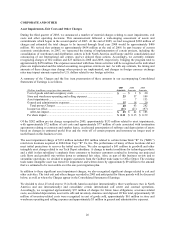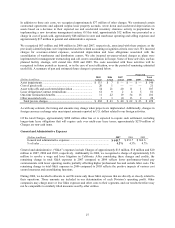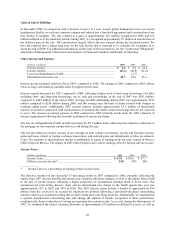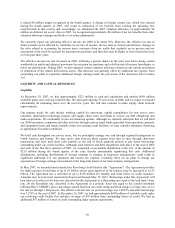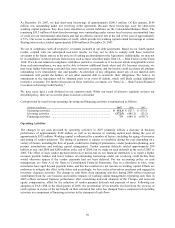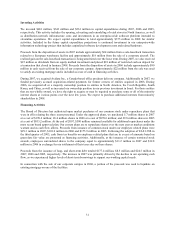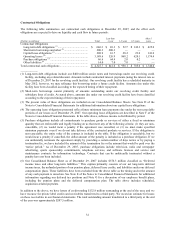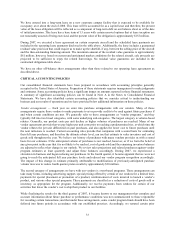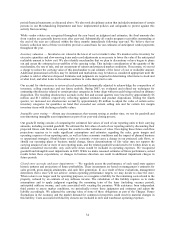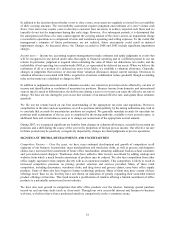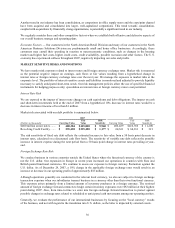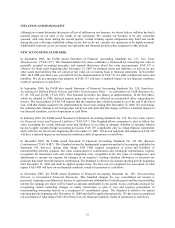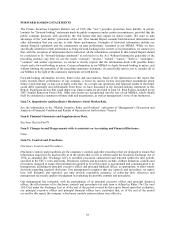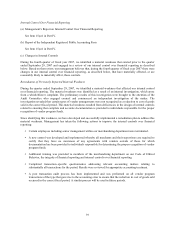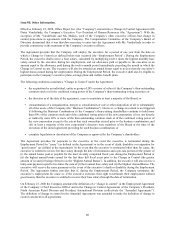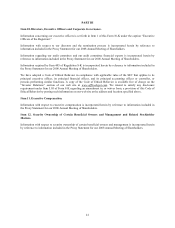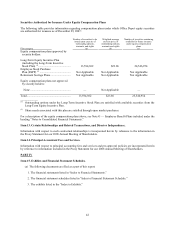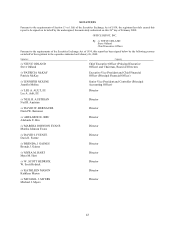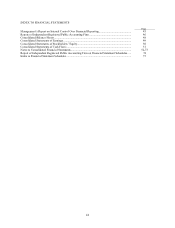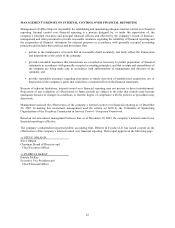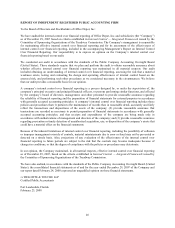Office Depot 2007 Annual Report Download - page 38
Download and view the complete annual report
Please find page 38 of the 2007 Office Depot annual report below. You can navigate through the pages in the report by either clicking on the pages listed below, or by using the keyword search tool below to find specific information within the annual report.
36
Another trend in our industry has been consolidation, as competitors in office supply stores and the copy/print channel
have been acquired and consolidated into larger, well-capitalized corporations. This trend towards consolidation,
coupled with acquisitions by financially strong organizations, is potentially a significant trend in our industry.
We regularly consider these and other competitive factors when we establish both offensive and defensive aspects of
our overall business strategy and operating plans.
Economic Factors — Our customers in the North American Retail Division and many of our customers in the North
American Business Solutions Division are predominantly small and home office businesses. Accordingly, these
customers may curtail their spending in reaction to macroeconomic conditions, such as changes in the housing
market and higher fuel costs, higher credit costs, credit availability, possible recession and other factors. The U.S.
economy has experienced softness throughout 2007, negatively impacting our sales and profits.
MARKET SENSITIVE RISKS AND POSITIONS
We have market risk exposure related to interest rates and foreign currency exchange rates. Market risk is measured
as the potential negative impact on earnings, cash flows or fair values resulting from a hypothetical change in
interest rates or foreign currency exchange rates over the next year. We manage the exposure to market risks at the
corporate level. The portfolio of interest-sensitive assets and liabilities is monitored and adjusted to provide liquidity
necessary to satisfy anticipated short-term needs. Our risk management policies allow the use of specified financial
instruments for hedging purposes only; speculation on interest rates or foreign currency rates is not permitted.
Interest Rate Risk
We are exposed to the impact of interest rate changes on cash equivalents and debt obligations. The impact on cash
and short-term investments held at the end of 2007 from a hypothetical 10% decrease in interest rates would be a
decrease in interest income of less than $1 million.
Market risk associated with our debt portfolio is summarized below:
2007 2006
(Dollars in thousands) Carrying Value
Fair
Value
Risk
Sensitivity Carrying Value
Fair
Value
Risk
Sensitivity
$400 million senior notes ....... $ 400,384 $ 415,840 $ 9,960 $ 400,489 $410,360 $ 11,200
Revolving Credit Facility ....... $ 235,420 $ 235,420 $ 1,177 $ 64,361 $ 64,361 $ 321
The risk sensitivity of fixed rate debt reflects the estimated increase in fair value from a 50 basis point decrease in
interest rates, calculated on a discounted cash flow basis. The sensitivity of variable rate debt reflects the possible
increase in interest expense during the next period from a 50 basis point change in interest rates prevailing at year-
end.
Foreign Exchange Rate Risk
We conduct business in various countries outside the United States where the functional currency of the country is
not the U.S. dollar. Our expansion in Europe in recent years increased our operations in countries with Euro and
British pound functional currencies. We continue to assess our exposure to foreign currency fluctuation against the
U.S. dollar. As of December 29, 2007, a 10% change in the applicable foreign exchange rates would result in an
increase or decrease in our operating profit of approximately $18 million.
Although operations generally are conducted in the relevant local currency, we also are subject to foreign exchange
transaction exposure when our subsidiaries transact business in a currency other than their own functional currency.
This exposure arises primarily from a limited amount of inventory purchases in a foreign currency. The notional
amount of foreign exchange forward contracts to hedge certain inventory exposures were $92 million at their highest
point during 2007. Also, from time-to-time we enter into foreign exchange forward transaction to protect against
possible changes in exchange rates related to scheduled or anticipated cash movements among our operating entities.
Generally, we evaluate the performance of our international businesses by focusing on the “local currency” results
of the business, and not with regard to the translation into U.S. dollars, as the latter is impacted by external events.


